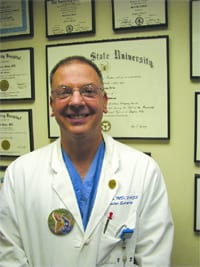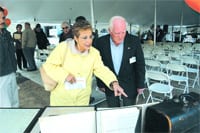Practicing Medicine — and Public Relations Vascular Surgeon and Administrator Mark Hirko Is Also Selling a New Model of Care
Dr. Mark Hirko wears a large button on his lab coat, a political campaign-style item bearing a picture of his daughter, Marie. He joked that she sent it to him, and asked him to wear it, so that he wouldn’t forget what she looks like.
He couldn’t possibly forget, because he flies home to the Pittsburgh area to see his family every few weeks. In fact, he’s become an expert at finding lower-cost routes and alternatives, such as meeting in New York and staying a night or two there.
“When I left Pittsburgh, we knew we’d have two years where we would be separated; when I took this job, I vowed that I wouldn’t take my kids out of high school,” said Hirko, as he explained his decision to join Baystate Health and become medical director of Baystate Vascular Services and chief of the division of Vascular Surgery — and the impact it has had on his home life.
He says he gets lonely sometimes and misses his family terribly, but then jokes (sort of) that they probably wouldn’t get to see him much if they did make the move to Western Mass. That’s because Hirko is quite busy these days with all that comes with those twin titles on his business card, including something that might be less obvious to some, an assignment he calls “public relations.”
Elaborating, he said this involves the comprehensive, and ongoing, task of obtaining buy-in for the operating strategy, or philosophy, as he called it, for the Vascular Center that will be at the heart of Baystate’s Hospital of the Future now taking shape on the system’s campus on Chestnut Street in Springfield.
Describing that philosophy, Hirko said it is grounded in the concept of streamlining the care process and removing most or all of the “silos and egos” he says get in the way with most health care providers.
“When you have vascular disease, it affects every organ system of the body; it involves the heart, the kidneys, the endocrin organs … everything,” he explained. “We’re looking at how we can streamline this care, because right now, if you have those health problems, you have to go to five or six different clinics in four different buildings, and you may see eight or nine different doctors.
“How do you coordinate that care?” he asked while starting to answer that question. “There are so many people that are overlapping with care that you’re not really seeing the kind of efficient care you want and need.”
Change comes slowly and not easily, he continued, noting that to emphasize the breath and depth of what Baystate is doing, the system has put to use a new slogan of sorts when it comes to the Vascular Center: ‘It’s more than Building.’ It was chosen, said Hirko, to drive home the point that the new facility is about much more than bricks, mortar, and glass. Instead, it’s about this combined model of care that he is now aggressively selling.
So how does one achieve buy-in? By spending countless hours talking about how this approach is better for patients, better for the system, and (this is the hardest part) better for individual physicians who are afraid they’re going to lose business with such a model.
In this, the latest installment of The Health Care News’s ‘Today’s Physician’ series, we talk with Hirko about the many hats he wears, and especially his work handling a different kind of public relations.
A Team Approach
A native of the Cleveland area, Hirko wears his heart on his sleeve, and decorates his office accordingly, when it comes to the sports teams he grew up following — and still follows today.
There’s a Cleveland Browns license plate, as well as some items bearing Ohio State University themes and colors. There’s a also a framed photo of Jacob’s Field, home to the Indians, and a caricature of Hirko in the stands at ‘The Jake,’ with an Indians hat on, drawn while he was doing his residency.
“We had some great teams for a number of years,” he said, running through the vaunted ‘Tribe’ lineups from the mid-to late ’90s, and lamenting the fact that those teams came close (appearances in the1995 and 1997 fall classics) but didn’t end a championship drought that goes back to 1954.
He also recounted, and lamented, the shaping of the Browns into a title contender in the mid-90s, only to see the team jell and win a Super Bowl after it had been relocated to Baltimore.
While Hirko is a true sports fanatic, his passion has always been science and medicine. It’s been that way since junior high school, and his interest in those fields jelled at the University of Akron, where he earned first a bachelor’s and then a master’s in biology. He attended medical school at Wright State University in Dayton, Ohio, and for his residency (in general surgery) he ventured to the other side of the state, specifically Akron City Hospital.
From there, he went to Chicago and Loyola University Medical Center for a research fellowship and then a clinical fellowship, both in vascular surgery. These were followed by some traveling fellowships that took him from the Bronx to Phoenix.
His first post-training assignment was at Forum Health in Youngstown, Ohio, affiliated with the Case Western Reserve system, where he served as surgical director of the Wound Healing Center. Over a 12-year stint there, he became division chief of vascular surgery and program director in general surgery.
“And that’s when the fun begins,” he said in a voiced laced with sarcasm, noting that he was about to begin a strange phase of his career, one with health care providers that found themselves in deep financial trouble.
“I was pretty stable in my career and happy with everything, and then, in 2005, they sat us down and told us that their $40 million expansion, which had been started, was scrapped, and they were bankrupt,” he recalled. “They told us that our retirement and some of our disability and all that was lost.”
Seeking higher ground, Hirko took a job as chief of the Division of Vascular Surgery at The Western Pennsylvania Hospital in Pittsburgh in June 2006. But bad luck followed him there.
“Even though I checked their background and I checked their financials, the department of surgery actually dissolved, because they were in a merger mode,” he explained. “In a matter of a year and a half, our department of surgery went from 40-some people down to 16; it was a shadow of its former self.”
By spring of 2007, Hirko had begun another job search, with the stated goal of finding a health care system on some solid financial footing. Actually, there was much more on his list of criterion.
In the Right Vein
“I was searching for a place that was looking to do what we were trying to do in Ohio two jobs before,” he said, “and that is to put in place a multi-disciplinary system for the vascular patient, which is the modern way of performing care for these patients.
“At a lot of places, such as the Cleveland Clinic, the Mayo Clinic, and others, departments are starting to go by the wayside,” he continued. “Instead, you’re seeing lines of care, or centers of care, where you may have an aneurism program that has six or seven disciplines, bringing four or five departments together, checking aneurisms, or you may have a dialysis-access program, similarly, with four or five different disciplines taking care of dialysis patients.”
Vascular patients can be taken care of in the same way, he said, explaining both what brought him to Baystate — a plan to develop such a center in the new Hospital of the Future — and much of the non-clinical work he’s doing these days — building a consensus on how such a plan can and should come together.
“I looked at Chicago, at some programs in Cleveland, and at one in Dayton,” he said. “As I started looking, I realized that first, there weren’t many systems that were trying to do this modern model of care, and the ones that had tried in the past had failed miserably, because you have those silos and egos.”
Elaborating, he said that people in power usually don’t want to give up that power, and this has been an insurmountable hurdle for most systems. At Baystate, he saw potential to overcome the obstacles and, in a word, “upside.”
“This program had a lot more of it than some of the others,” he explained. “It was just beginning to set up the bond program for a $260 million buildout, they had already developed the infrastructure for this interactive model of care, and they just needed to get the pieces together and get the ship moving.”
Getting a buy-in is not easy, however, and Baystate has already lost several physicians since it announced its commitment to this new way of doing business, said Hirko, who remains confident that this system will get where it wants to go.
“The reason why this type of collaboration has failed,” he said, “Is because of the egos that get in the way; people taking care of certain things they’re good at, but not looking at the combined, overall encompassing care of the patient.
“Here, we’ve actually gotten beyond a lot of the egos and the personalities,” he continued. “People are saying, ‘maybe there are other people here who can take care of this problem better than we know how, but we won’t be fearful of losing this patient for monetary reasons, because we know we’re going to get other patients in return; there’s a lot of give and take.”
The challenge of selling such profound change is one of the things that appeals to Hirko about his new position and its many responsibilities. Another is the opportunity to succeed where so many have failed or come up short in the past, and create a model that others could emulate.
“This is a big leap and somewhat of a blind leap,” he said. “But this could be an example for a lot of people if we do this right. That’s what is so exciting about this.”
Hitting it on the Button
As he talked about his button, his daughter, and the time they’ll be apart, Hirko, noting that he’s been at Baystate nearly a year, said, “we’re about half-way home.”
He’s not ready to make such a calculation on his job selling the new integrated model of care that will be employed at the Hospital of the Future. But he says that he and others are making progress with this complex transformation in the way care is delivered.
In other words, there’s more public relations to do.



